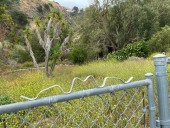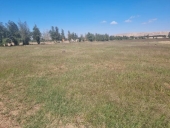




800 square meters
Temperate climate (south Ukraine). Snow in winter, hot summers.
Rains are really rare
Slope is about 10 degrees.
Soil seems to be clay. Really exhausted.
No one worked there for several years so it tends to be covered by grass.
 1
1




Hey there! I'm another European working on a Temperate-Zone Forest Garden (in Denmark). The first thing you are going to want to do is get your trees, as they will take the longest to set fruit: I have compiled a guide to a temperate forest garden: the text is in Danish, but I have all of the plant names in English and Latin, as well as pictures. You can download it here:
In creating the garden, I ordered a lot of young trees from private sellers in the UK on eBay: it's the cheapest way to do it, and there are no problems shipping within Europe. Some of them were only 3 Euro.
Books that I have found helpful:
I also have done a series of posts on the topic on my personal blog, which you can check out:
Good luck! Forest gardens are amazing, but they take a lot of work to get started.
Seed swaps, polyculture gardening info, forest gardening tutorials, bioregionalism mapping, rare germplasm sales, and more at http://biodiverseed.com




 2
2




















Chris Badgett
Cocreator of Organic Life Guru. Have you seen what's happening over there?
 1
1








ourochreway.com-- Our Homesteading Blog about permaculture, life, and other things




more "stuff" of many sorts should be coming onto the site than are leaving it. Compost materials of all sorts, mulches, organic matter, paper and cardboard, wood chips and brush and the like.
The idea is to create a contour design for your property, which is basically taking level lines from one boundary to the other
Run some animals over the land
Follow them with your pioneer species. Plant densely, so you can sacrifice them over the years and coppice them for mulch. At the same time, plant your long term fruit and nut species. This is time stacking. These trees will grow up amongst your pioneers, eventually taking over as you disadvantage the mulch making and nitrogen fixing bushes and trees.








Nikita Sidorenko wrote:bob day, thanks for your reply!
First of all, there are no or a few cattle and wildlife.
Irrigation water is available several days per week.
I'm not sure if it's possible to get water from any other source since rains are really rare and site is situated on the high position of the hill. Not the highest but close to it. I was thinking about making sort of a drip irrigation.
Do you have any ideas of water distribution in such a dry area? Make a focus on irrigation water?
So the first steps I see:
1) Start compost pile
2) Plant cover crop
3) Think about water distribution
Does it make sense?
Freakin' hippies and Squares, since 1986












 I doubt that the soil is 'exhausted', since you say it hasn't been worked for several years and it is growing grass. It may just be a little compacted, being clay and all, but if you dig in some organic matter, you should be pleasantly surprised with what it can grow. If you want it to perform really well, then dig in a lot of organic matter (in the form of a hugelbed), and it will be set in case you have a dry spell in the summer months.
I doubt that the soil is 'exhausted', since you say it hasn't been worked for several years and it is growing grass. It may just be a little compacted, being clay and all, but if you dig in some organic matter, you should be pleasantly surprised with what it can grow. If you want it to perform really well, then dig in a lot of organic matter (in the form of a hugelbed), and it will be set in case you have a dry spell in the summer months.







| I agree. Here's the link: http://stoves2.com |







